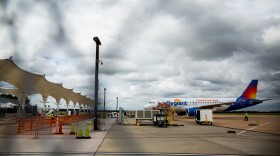With the nation’s critical shortage of air traffic controllers in the spotlight on Capitol Hill on Thursday, City Council unanimously adopted a measure to beef up safety at Austin-Bergstrom International Airport.
Council ordered Aviation Department staff, who run the publicly owned airport, to fast-track the rollout of a system that would direct planes as they’re pulling in and out of the Barbara Jordan Terminal. Right now, no one’s playing traffic cop.
The so-called "Ramp Control Program" had been in the works since last year with a planned deployment sometime around 2025. Now, a temporary system will fill the gap, possibly launching by the end of the year.
Airport officials must now immediately notify the City Council and airport commission when a near-miss or other serious event happens. The resolution by Council Member Vanessa Fuentes follows a year of close calls in the sky and two deaths on the ground at ABIA.
“The seriousness of the critical incidents we’ve had at the airport … has prompted this resolution for us to take action,” Fuentes said after the vote.

The resolution calls on city staff “to routinely engage with the Air Traffic Control Tower to discuss and mitigate safety risks.” Air traffic control is the exclusive jurisdiction of the Federal Aviation Administration. ABIA officials and politicians have clashed over how much the city can affect air safety.
Austin has no power over the airspace or runways at the airport, but the city “will remain diligent in working with the FAA and other federal agencies,” interim Assistant City Manager Robert Goode wrote in a memo to the mayor and council members this week.
The memo sought to push back against accusations that the city wasn’t doing enough to boost safety at the airport.
For example, Goode said the reason ABIA lacks a ground radar system was because the FAA stopped deploying the system before Austin was big enough to qualify. The system, which exists at 35 of the largest airports in the country, helps air traffic controllers know exactly where planes are located on the ground.
The FAA is seeking next generation technology for ground monitoring, but has no plans to buy anything yet. Once the FAA does acquire new technology, the city will try to secure the ground monitoring equipment for ABIA, Goode said.
For some officials, the survey of safety efforts is coming frustratingly late.
“We have been asking for safety measures and for a briefing from staff [for months],” Airport Advisory Commission Chair Wendy Todd said at this week’s meeting of the 11-member panel appointed by Council. “We want to be your partners in moving this along quickly.”

The union representing air traffic controllers is applauding the City Council's action, saying local safety measures and support for a bill in Congress to reauthorize FAA funding will help strengthen the system.
Staffing at Austin’s air traffic control tower has not kept up with ABIA’s rapid growth over the past few years, said Blake Futrell, an air traffic controller at ABIA and a representative of the National Air Traffic Controllers Association, in a letter to Council.
“I support the City of Austin and their efforts to create more barriers to catastrophe in our ‘Swiss Cheese’ model,” Futrell said, referencing a theory on risk aversion. “In a complex system, such as air traffic control, hazards are prevented from catastrophe by a series of barriers.”
Thursday's Council vote came as a panel of U.S. senators heard top federal officials sound the alarm about a dangerous shortage of air traffic controllers nationwide. A February incident at ABIA in which a FedEx jet almost crashed into a Southwest Airlines plane with 128 people on board was cited as a symptom of the crisis.
The senators were told the pace of controller hiring is so slow that it would take another 10 years just to reach the staffing targets from a decade ago.
“Absolutely, I am worried about safety,” National Transportation Safety Board Chair Jennifer Homendy said in response to a question from Sen. Ted Cruz, R-Texas, the ranking member on the committee.
“Air traffic controllers are being required to do mandatory overtime, and what happens with mandatory overtime?” Homendy asked rhetorically. “It ends up leading to fatigue and distraction, which is exactly what we're seeing as part of these incident investigations.”









